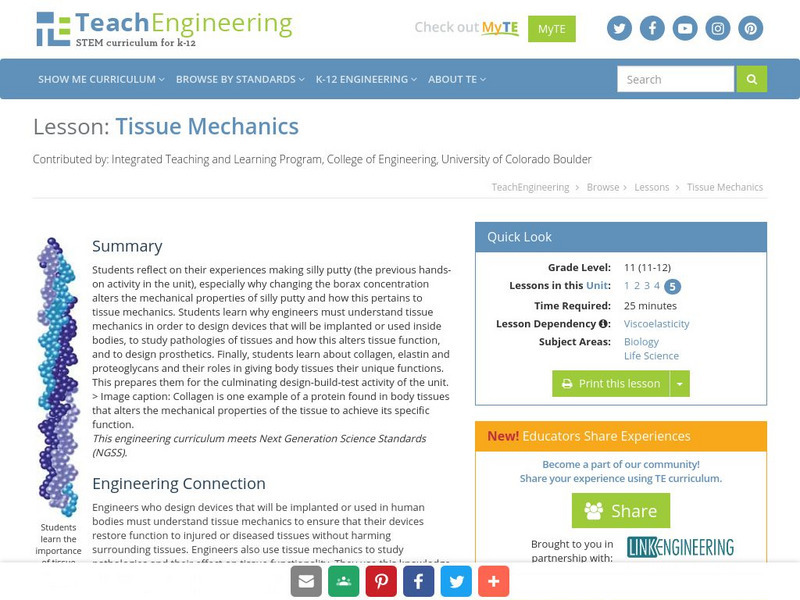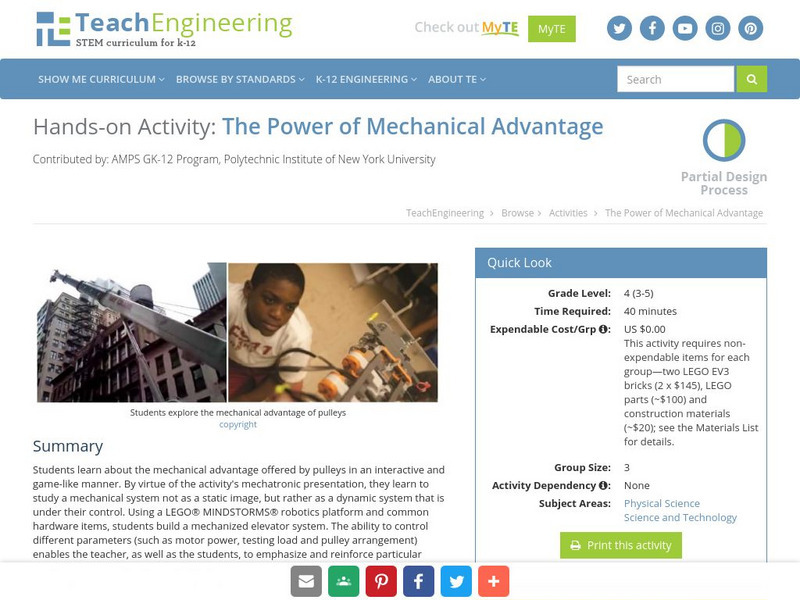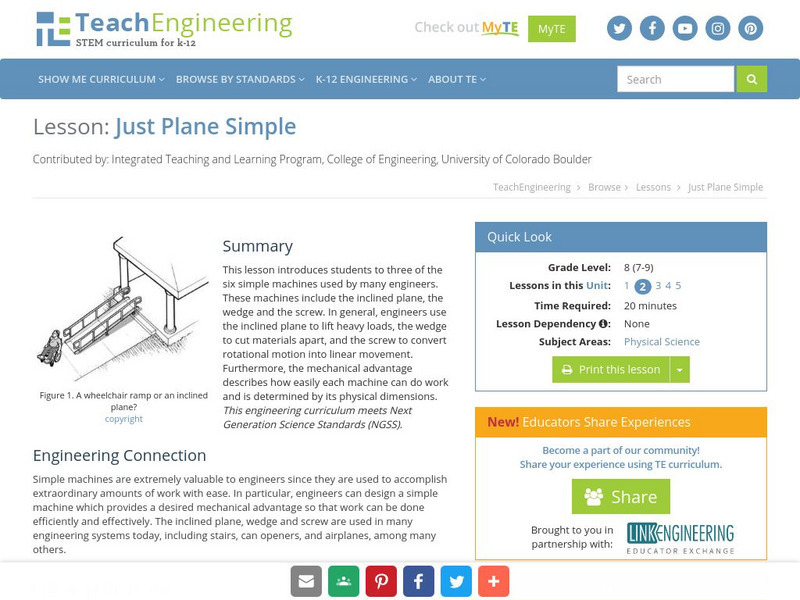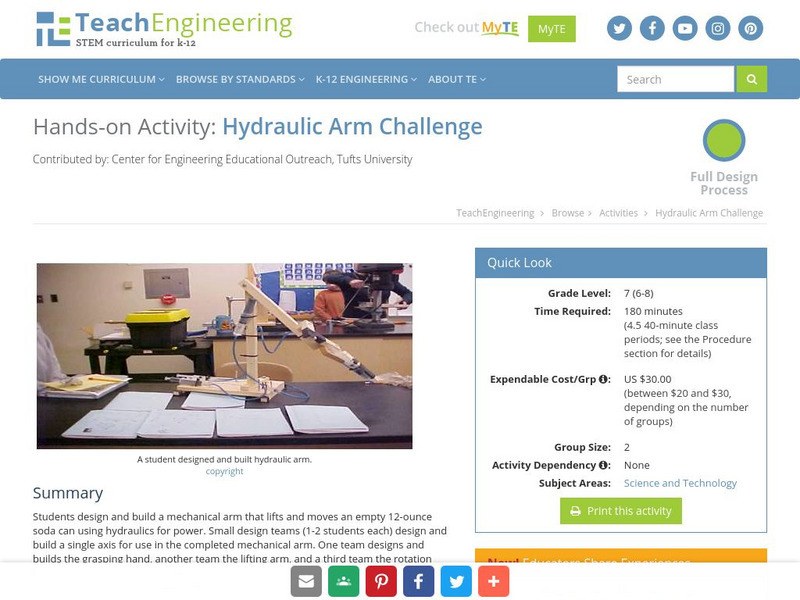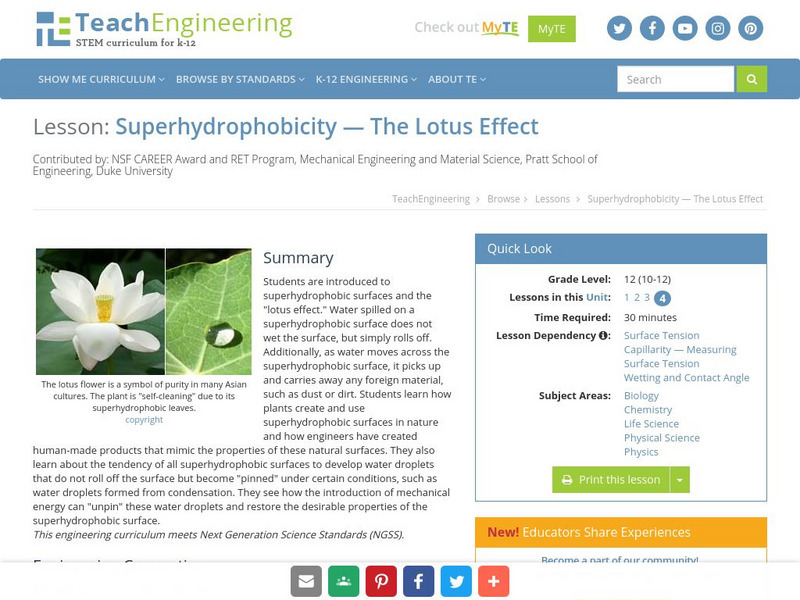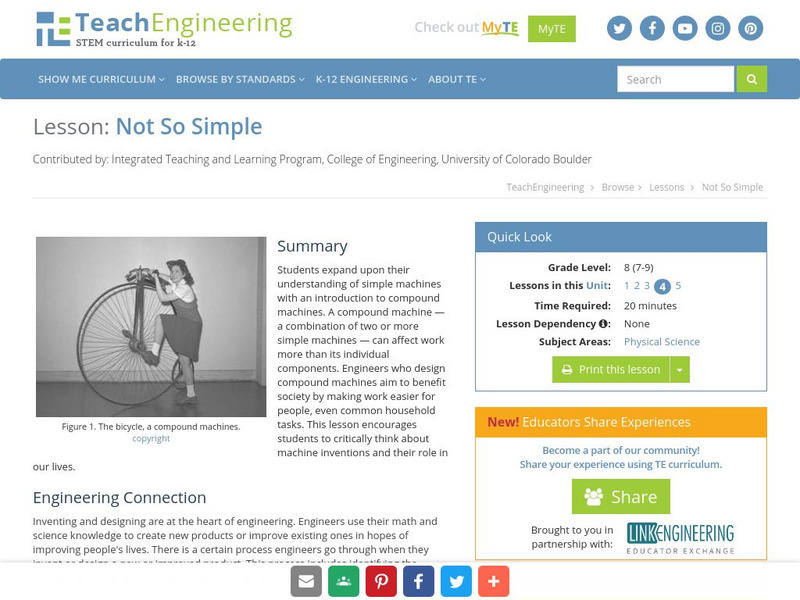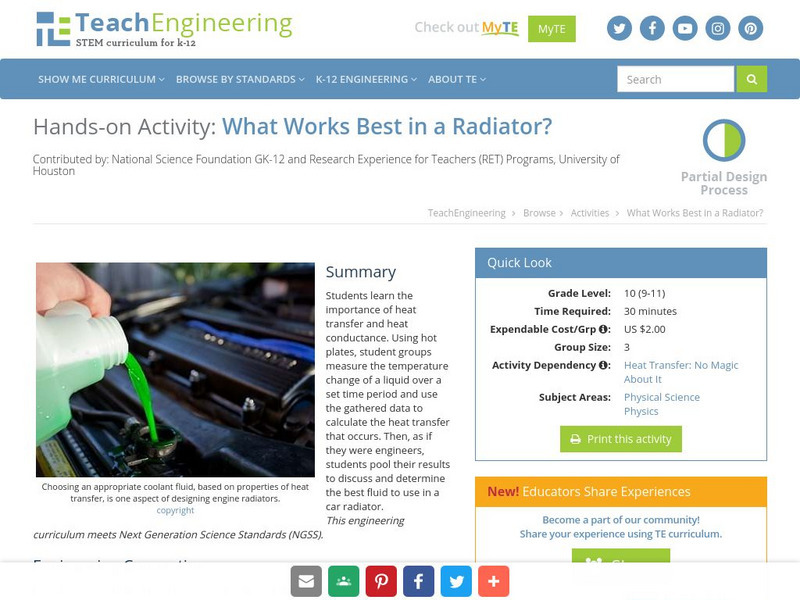TeachEngineering
Teach Engineering: Ding! Going Up? Elevators and Engineering
Students create model elevator carriages and calibrate them, similar to the work of design and quality control engineers. Students use measurements from rotary encoders to recreate the task of calibrating elevators for a high-rise...
Other
The Engineering and Science Foundation: Engineering Your Future
Authors invite students to explore this site in order to gather information about a future engineering career. Information is provided on various fields such as chemical and biomedical. Site also lists important classes related to the...
TeachEngineering
Teach Engineering: Fascinating Friction!
In this activity, students use wood, wax paper and oil to investigate the importance of lubrication between materials and to understand the concept of friction. Using wax paper and oil placed between pieces of wood, the function of...
TeachEngineering
Teach Engineering: Tissue Mechanics
Students reflect on their experiences making silly putty (the previous hands-on activity in the unit), especially why changing the borax concentration alters the mechanical properties of silly putty and how this pertains to tissue...
TeachEngineering
Teach Engineering: Tools and Equipment, Part I
Through a series of activities, students discover that the concept of mechanical advantage describes reality fairly well. They act as engineers creating a design for a ramp at a construction site by measuring four different inclined...
TeachEngineering
Teach Engineering: The Power of Mechanical Advantage
Students learn about the mechanical advantage offered by pulleys in an interactive and game-like manner. By virtue of the activity's mechatronic presentation, they learn to study a mechanical system not as a static image, but rather as a...
TeachEngineering
Teach Engineering: Just Plane Simple
This lesson introduces students to three of the six simple machines used by many engineers. These machines include the inclined plane, the wedge and the screw. In general, engineers use the inclined plane to lift heavy loads, the wedge...
TeachEngineering
Teach Engineering: Machines and Tools, Part Ii
In this activity, students gain first-hand experience with the mechanical advantage of pulleys. Students are given the challenge of helping save a whale by moving it from an aquarium back to its natural habitat into the ocean. They set...
TeachEngineering
Teach Engineering: My Mechanical Ear Can Hear!
Students are introduced to various types of hearing impairments and the types of biomedical devices that engineers have designed to aid people with this physical disability.
TeachEngineering
Teach Engineering: Hydraulic Arm Challenge
Students will design and build a mechanical arm that lifts and moves an empty 12-ounce soda can using hydraulics for power. Small design teams (1-2 students) will design and build a single axis for use in the completed mechanical arm....
Technovation
Curiosity Machine: Challenges: Make a Mechanical Leg
This website challenges students to make a ball and socket joint that mimics the movement of a human hip or shoulder. Using only a tennis ball, rubber bands, cardboard, and tape, students will construct this mechanical device. The site...
Technovation
Curiosity Machine: Challenges: Design a Set of Mechanical Genes
Design a set of mechanical genes that control the way something grows with this challenge on this site. This site also includes tips, a lesson plan, and a place for students to document their engineering design process.
TeachEngineering
Teach Engineering: Action Reaction Rocket!
Students make a rocket that travels along a string to discover the role that Newton's Laws of Motion play in engineering.
Technovation
Curiosity Machine: Challenges: Make a Mechanical Theater
Make a simple machine that creates characters for a theater show on this site. This site contains a lesson plan, tips, and a place for students to document their engineering design process.
TeachEngineering
Teach Engineering: Gravity Fed Water System for Developing Communities
Students learn about water poverty and how water engineers can develop appropriate solutions to a problem that is plaguing nearly a sixth of the world's population. Students follow the engineering design process to design a gravity-fed...
TeachEngineering
Teach Engineering: Feel the Stress
Working individually or in groups, students explore the concept of stress (compression) through physical experience and math. They discover why it hurts more to poke themselves with mechanical pencil lead than with an eraser. Then they...
TeachEngineering
Teach Engineering: Superhydrophobicity: The Lotus Effect
Students are introduced to superhydrophobic surfaces and the "lotus effect." Water spilled on a superhydrophobic surface does not wet the surface, but simply rolls off. Additionally, as water moves across the superhydrophobic surface, it...
TeachEngineering
Teach Engineering: Team Up!
Students explore the physical and psychological effect of stress and tension on human beings. They develop their observing, thinking, writing and teamwork skills by working on a group art project and reporting about it. They learn about...
TryEngineering
Try Engineering: Cast Your Vote
Students learn about the engineering design process as they design, build, test, and evaluate a voting system made with everyday materials. The objective of the lesson plan is to learn how engineering has changed methods of voting over...
Learn Engineering
Learn Engineering: What Is Von Mises Stress?
In this article and video, learn about how engineers can use the Von Mises stress to predict when their design will fail. By completing the calculations, engineers can find the maximum value of Von Mises and can be more accurate with the...
TryEngineering
Try Engineering: Get It Write
Students learn about the engineering design process by working in teams to design and build a pen out of everyday materials that can deliver a controlled amount of ink to a sheet of paper.
TeachEngineering
Teach Engineering: Strong Arm Tactics
Students generally do not know the complexity that goes into building and programming a robotic arm. In actuality, creating such an arm comes from a design that involves mechanical, electrical, and computer science engineers. This...
TeachEngineering
Teach Engineering: Not So Simple
Students expand upon their understanding of simple machines with an introduction to compound machines. A compound machine - a combination of two or more simple machines - can affect work more than its individual components. Engineers who...
TeachEngineering
Teach Engineering: What Works Best in a Radiator?
Students learn the importance of heat transfer and heat conductance. Using hot plates, student groups measure the temperature change of a liquid over a set time period and use the gathered data to calculate the heat transfer that occurs....





